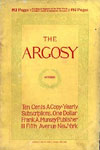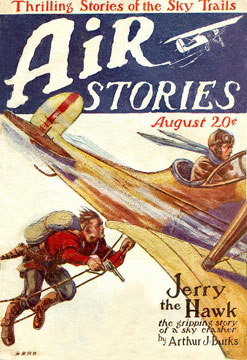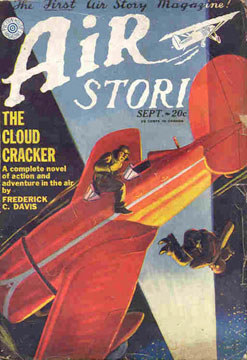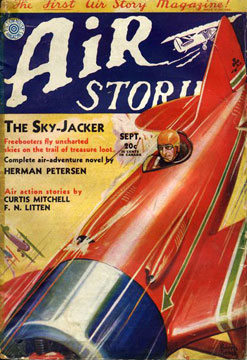Air Stories: The First Air Story Magazine!
In May 1927 Charles Lindbergh made his world-famous solo flight across the Atlantic, catapulting himself (and The Spirit of St. Louis) into the history books and America into an "air-minded" frenzy. The "golden era" of aviation fiction had begun. In the next five years, 148 aviation series and dozens of aviation pulps like Air Trails, Air Adventures, Dare-Devil Aces, Flying Aces, Sky Trails, and Wings would come into print.
Amid stiff competition, Fiction House's Air Stories, edited by Jack B. Kelly (1927-1932) and Malcolm Reiss (1937-1939), held a unique bragging right; its first issue appeared in August 1927, making it "The First Air Story Magazine!" as prominently advertised on many of the magazine's covers. Air Stories not only could claim status as a "first," but also often featured some of the most popular talent in the aviation genre. The artwork of Rudolph Belarski, Frank Tinsley, and Frederick Blakeslee, the top three air-war illustrators of the day, regularly graced Air Stories's covers, and its pages were filled with stories by the likes of Thomson Burtis, author of the Rex Lee series, and George Bruce, whose popularity led to three aviation pulps being named after him.
By far the writer most frequently featured on covers of Air Stories, Bruce was promoted as the "war ace who fought on three fronts." He specialized in World War I tales centering on a rookie pilot who must prove himself. The majority of the magazine's content, however, did not focus on wartime adventures. Instead, Air Stories called for and printed a wide range of scenarios and characters, including passenger airlines, border patrol pilots, stunt aviators, cowboys, thieves and detectives, and even a "love interest" or two—so long as "the romance did not subordinate the main fast-climbing, wide-ranging air-adventure theme of the story." From the magazine's first issue, its "air stories" actually offered a wide-ranging blend of popular adventure genres.
In fact, many of Air Stories's best writers were known for their work in other genres, carrying the styles and plots of those genres into their aviation fiction. For instance, Frederick C. Davis was regularly featured on the magazine's cover, though he is primarily known for his mystery novels and his work on Operator #5—a pulp he co-wrote about the bloody adventures of a secret agent. His aviation fiction, in turn, frequently uses mystery and horror-story elements. Frederick L. Nebel, a member of the Black Mask school of pulpsters, penned a popular series about the vagabond pilots Gales and McGill, two soldiers of fortune in the Orient. And the prolific Lester Dent of Doc Savage fame made one of his first cover appearances with the zeppelin story "The Frozen Flight" in a 1931 issue of Air Stories. In 1939, the magazine even took a decidedly science-fiction turn in a failed attempt to hold onto its popularity.
With the magazine's close connections to detective and mystery writers, Air Stories perhaps unsurprisingly targeted an adult male audience with violence ubiquitous in its pages in the form of gunplay, murder, and pilots plummeting to their deaths. Common plots and themes include male competition and bonding, as well as untried or disgraced men asserting their manhood and bravery in the face of impossible odds. Even so, one of the magazine's most interesting aspects is the role female characters occasionally came to play.
The women in Air Stories appear as news reporters, explorers, and pilots. The first issue, for example, includes a story about Astra Sanderson, a "trail-hardened," automatic-toting young woman who possesses "in addition to startling beauty, a will of her own" and who bravely rescues the pilot-hero more times than he rescues her. And then, there is Barbe Privet, an Air Stories character created by Herman Peterson. This female pilot looks for treasure and battles dastardly men in the South Seas with her trusted sidekick Roy Burnett. In fact, in its other publications Fiction House showed a similar tendency to create strong, positive female role models, with Sheena, Queen of the Jungle, becoming their most popular character.
Air Stories drew its audience and popularity from that "air-minded" public inspired by Lindbergh and other celebrity pilots. The magazine presented a long-running series about "How to Become a Pilot" for those wishing to emulate the men in its stories, and it concluded early issues with purportedly true feats of aviation from Air Stories readers. As the "golden era" of aviation fiction came to an end in the thirties, however, so did interest in Air Stories, and after its 58th issue, the magazine was discontinued in the winter of 1939.
Alexandra Blair, The University of Mississippi
Works Cited and Consulted
Kelly, J.B. (Air Stories editor), Where and How to Sell Manuscripts: A Directory for Writers (1931).
Sampson, Robert. Yesterday's Faces: Dangerous Horizons. Popular Press, 1991.
Sullivan, Larry E., and Lydia Cushman Schurman. Pioneers, Passionate Ladies, and Private Eyes: Dime Novels, Series Books, and Paperbacks. Psychology Press, 1996.
Robinson, Frank M., and Lawrence Davidson. Pulp Culture: The Art of Fiction Magazines. Collectors Press, Inc., 1998.





